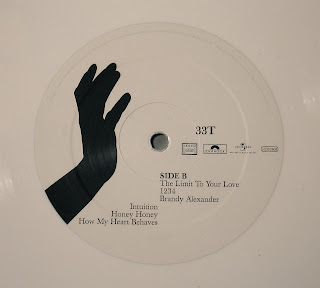
Out of control at the KUSF Rock 'n' Swap and SF Amoeba:
Ketty Lester, Ketty Lester (Pete Records, $5). I'm always on the look out for obscure 60's and 70's soul singers, many of whom are undeservedly neglected. Ketty turns out to have had an inconsistent career as a singer and actress, including a supporting role on Little House on the Prairie, according to Wikipedia. There were black people on that show? (File under: Folk-Soul)
Buckingham Nicks, Buckingham Nicks (Polydor, original pressing with gatefold cover, $5). Stevie and Lindsay's album before joining Fleetwood Mac. (File under: Music Gods)
Neil Young, After the Gold Rush (Reprise orange and tan label, original pressing, $3). I've been looking for years for a copy with the orange-and-tan label. I was beginning to think they didn't exist. After the Gold Rush was pressed with the orange-and-tan label for a few months before Reprise changed to an all-tan label. So this is a very early pressing. (File: Young Neil)
The Kinks, Arthur (Reprise orange and tan label, original pressing, $4). Classic Kinks albums from the 60's are hard to find. In contrast, their 70's albums are everywhere. Check underneath your sofa cushions. You'll probably find one there. (File under: Sibling Rivalries)
Blow-Up Soundtrack (MGM, original pressing, $5). Herbie Hancock composed the score for this Antonioni film. Another album I've been looking for for years. (File under: Jazz for Pretentious Italians)
Gato Barbieri, Chapter Two: Hasta Siempre (ABC Impulse, $3). I'm sure there'll be a time I'm in the mood to listen to a former free-jazz saxophonist playing like a banshee backed by a heavy Latin rhythm section. (File under: Screaming Argentinian Saxophonists)
Bob Dylan, Down in the Groove (Columbia 1A/1A stampers, $3). I confess, I won't be satisfied until I have all his albums, including the mediocre ones (File under: Meh Dylan)
Bob Dylan, Shot of Love (Columbia, $2). See above.
Tom Waits, Mule Variations (Anti-, $10). There's a strange phenomenon in collecting that an album becomes more desirable after it goes out of print.
Nina Simone, At Town Hall (Colpix, original pressing, $2). It seems the Nina Simone revival is over, judging by the number of her albums in the used bins. Good! (File under: Androgynous Singers Imitated by Cee-Lo)
The Tremeloes, Here Comes My Baby (Epic yellow label, $2). Not sure why I bought this. Perhaps it'll bring me happiness. (File under: Pure Pop for Not So Now People)
Vince Guaraldi Trio, Jazz Impressions of Black Orpheus (Fantasy stereo, original pressing on blue vinyl, $5). This has got to be one of the best-selling jazz albums of all time based on the number of used copies I've come across. I'd been holding out for a clean, affordable original pressing. (File under: Vince Guaraldi, Pre-Charlie Brown)
Cal Tjader, Plays Harold Arlen (Fantasy stereo, original pressing on blue vinyl, $5). The vibraphone can make me happy. It can also get me annoyed. (File under: Vibes, Good or Vibes, Bad--to be determined)
Mile Davis, The Complete Birth of the Cool (Capitol yellow label, 70's reissue? $2)
Freddie Hubbard, Red Clay (CTI, Van Gelder stamped in the dead wax, $7). This is one of the more difficult Hubbard CTI albums to find and probably one of his best. (File under: Good Jazz Albums with Bad Titles)
LA4, Just Friends (Concord, $2). The direct-to-disc version of this album sells for a lot. This isn't one of them, but the music should be fine with a line-up of Laurindo Almeida, Bud Shank, Ray Brown, and Jeff Hamilton. (File under: Jazz Albums with Sexually Ambiguous Titles that Require Further Explanation)
MFSB, Love Is the Message (Philadelphia International, $2). This album has one of the grooviest tunes ever recorded, "T.S.O.P." used for the theme to Soul Train. (File under: Music for an Ass Shaking)
The Smiths, The Smiths (Sire, $5). This completes my Smiths LP collection on Sire. (File under: Last of the International Whiners)
Francoise Hardy, Mon Amour Adieu (Reprise orange and tan label, $8). I really like the one Francoise Hardy album I have. Her albums are really hard to come by though. Americans probably don't like albums with lyrics in a foreign language, although wordless foreign music is acceptable, like "The Macarena". (File under: Albums You Can't Understand)
The Universal Congress Of, Prosperous and Qualified (SST, $5). See previous Acquisitions post.
Thelonious Monk, The Golden Monk (Riverside blue label, 60's reissue of his classic 50's date with Sonny Rollins, $6)
Frank Sinatra, Sinatra Swings (Reprise custom Sinatra label, $3). The only thing better than happy Frank is sad Frank (File under: Preternaturally Sensitive Thugs)
Ella Fitzgerald, Sings the Irving Berlin Song Book (Verve deep-groove original pressing, 2-LPs, $3). Ella spelled backwards is Alle, which means "everything" in German. What more can I tell you? (File under: Ella uber alles)
Herbie Mann and the Bill Evans Trio, Nirvana (Atlantic mono original pressing, $1). I didn't know this album existed. I still have a hard time believing it even as I see it with my own eyes. (File under: Unholy Jazz Pairings)
Nirvana, In Utero (Geffen, 180g German pressing, new for $20). The German pressings of Nirvana albums are supposed to be the best sounding. (File under: Audiophile Grunge)
Nirvana, Unplugged in New York (Geffen, 180g EU pressing, new for $20). See above.






















